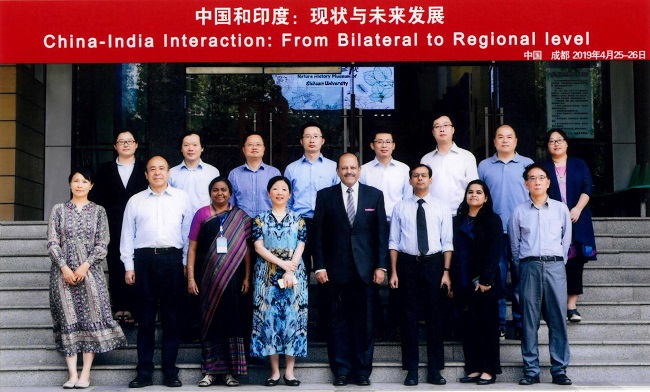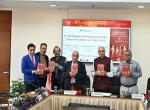The Center for South Asia-West China Cooperation and Development Studies (SAWCCAD) and the Institute of South Asian Studies (ISAS), Sichuan University, Chengdu, China, organised a conference on ‘China-India Interaction: From Bilateral to Regional Level’ on 25 April 2019. The participants from India were Amb. Sujan R Chinoy and Dr. Jagannath P. Panda from the Institute of Defence and Strategic Analysis, Dr. Teshu Singh from Vivekananda Internal Foundation and Dr. Lydia Powell from Observer Research Foundation. The Chinese side was represented by Dr. Wang Xu, Associate Professor & Executive Director, Center for South Asian Studies, Peking University, Dr. Li Tao, Executive Director, Dr. Yang Wenwu, Deputy Director, Dr. Zhang Li, Professor, Dr. He Ping, Professor, Dr. Liu Jiawei, Associate Professor & Director, Center for South Asia and West China Cooperation and Development (SAWCCDA), Dr. Liu Siwei, Associate Professor, Dr. Wang Juanjuan, Associate Professor, Dr. Zeng Xiangyu, Associate Professor, all from the Institute of South Asian Studies, Sichuan University and Dr. Zhang Chunyan, Associate Professor, College of Foreign Languages and Cultures, Sichuan University.
The welcome speech was delivered by Prof. Li Tao and the inaugural address was given by Amb. Sujan R Chinoy. The deliberations were divided into three sessions: India and China - The Way Ahead, China, India and Major Powers and China, India and their Neighborhood.

India and China: The Way Ahead
Both the sides highlighted the developments and achievements in their respective economy, society, political and diplomatic issues.
The Chinese participants expounded on the changes in Chinese diplomatic thinking stating that China’s new thinking is actually a response to the changing world situation. China is practicing big country diplomacy because it is conscious of her changing position. The rise of China has been reshaping how the country sees its own role in the world. China is moving on from norm taker to norm setter. Chinese diplomacy was much more concerned with the enhancement of China’s economic cooperation.
On the Chinese economy, the Chinese participant elucidated on the ‘China’s Supply-Side Structural Reform’. The world economic structure is undergoing profound adjustment. The supply-side structural reform forms the crucial aspect of China’s economy. The main driver of this reform is that the supply side is out of balance with the demand side in China, Hence it needs adjustments. In addition, firms are being pushed to make production more environmentally friendly. Promoting advanced industries and innovation in existing industries are also key features of the policy. On the Water Security Challenges, the Chinese participants explained that China is facing unprecedented challenges for managing its water resources. China’s annual water resources endowment is low on the per capita basis, which is about one-third of the world average. Hydro-cooperation between India and China was also proposed.
The Indian participants highlighted the achievements of the vibrant democracy and explained the major initiatives and social welfare programme started recently. The tenants of India’s Foreign Policy were also explained in details. India’s Energy Security: Strategic Challenges was also underlined.
China, India and Major Powers
Chinese participants elaborated on the India-US strategic engagement. Chronologically, the evolution of India-US relations was traced. The Chinese participants also emphasized that China’s diplomatic preference was to distance India from America’s Indo-Pacific agenda aimed at China.
On the issue of Quad, the Chinese participants reviewed the development of the security dialogue from a Chinese perspective. The evolution of the Quad in the foreign policy discourses of India, Australia, Japan and the US was brought out by the Chinese participants. The Chinese participants argued that there are differences and problem amongst the members of the Quad. Hence, Quad as a concept is unlikely to be successful. China’s response to Quad is essentially avoiding conflict and restoring peace in the region.
The Indian participants explained that the concept of Quad and Indo-Pacific should not be confused. It should not be seen as sinister. Quad is different from Indo-Pacific and is not a military or naval construct. The Indian participants emphasized that the Quad does not aim to counter the Belt and Road Initiative.
The Indian participants expounded on the Indian perspective of Indo-Pacific. The Indian perspective entails; a free, open, inclusive region, the centrality of Southeast Asia, rules-based order for the region, freedom of navigation, level playing field for all and connectivity for all in the Indo-Pacific region. The major connectivity initiatives that India is propagating are the trilateral highways, neighbourhood policy, go west policy, Bangladesh Bhutan India and Nepal (BBIN), connectivity projects in Central Asia and Asia Africa Growth Corridor (AAGC). The other maritime connectivity initiatives are: ‘Sagarmala’, cotton route, spice route, and project Mausam. The Indian participant argued that the concept of Indo-Pacific was not different from the Asia Pacific and India did not see China as a rival in the region.
On the ‘Future of Security Governance in the Bay of Bengal’, the Chinese participants argued that the big powers should concentrate on how to conserve resources in the region. Perhaps in future, they should talk about activities and look for bigger, Inclusive network to get big power to change their attitude in the region. The Chinese participants proposed that survivor dynamics should be considered for the region.
China, India and their Neighborhood
The Chinese participants highlighted the political and diplomatic reforms under President Solih's in the Maldives. The reforms are mainly based on the Maldivian Democratic Party (MDP) values and philosophy, which are political democratic and economic freedom. The Chinese participants highlighted that there is a change in orientation of the Maldivian government and the tilt is toward India and not China.
The Chinese participant elucidated on reforms and challenges of the Pakistan Economy. They traced the history of the IMF loans to Pakistan and stated that the long term goal of economic reforms in Pakistan is to cut down fiscal deficit. On the political front, Imran Khan has a weaker mandate and needs to form a coalition but has fewer financial resources at his disposals. Hence, Pakistan is trying to improve business cost and improve the business environment, improve the taxation policy, supporting the development of the special economic zone, improving the financing situation of the small and medium enterprises and agriculture.
On Afghanistan, the Chinese participants explained on the Afghanistan Reconciliation Process and China-India regional cooperation. In the context of Donald Trump's new strategy on Afghanistan and South Asia, the Chinese participant highlighted that Trump’s administration has changed its focus on South Asia and simultaneously, they have introduced the concept of Indo-Pacific. In this scenario, the strategic importance of Pakistan to the US has declined and hence the importance of Afghanistan has increased. The Chinese participant also proposed that India and China can explore cooperation based on two plus one models in Afghanistan.
To sum up, the discussion touched the various facet of India-China engagements in the neighbourhood. In fact, the concept of the neighbourhood was also discussed in detail. There was consensus on the issue that India and China should work together for maintaining peace and stability in the region.





Post new comment